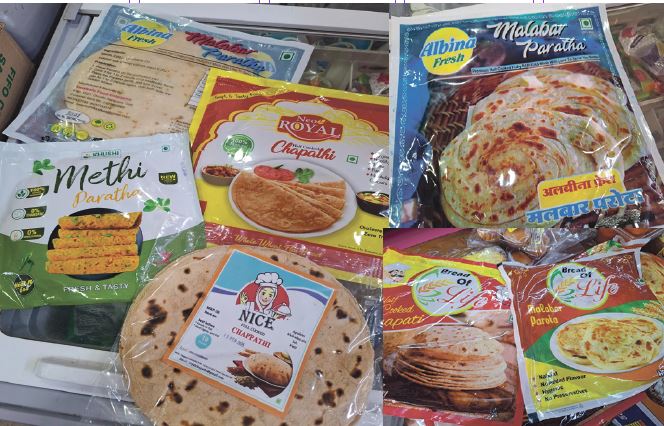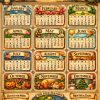Goa is abuzz with excitement as vintage bike and car owners, users, collectors and fans are decking […]

ANY NUMBER OF WHEAT FLOUR ROTI IN THE MARKET…Why no millet roti!
Eating is Fun / Eating is Yuck! - A variety food column, Feb 15- Feb 21 2025, Life & Living February 14, 2025Several brands of wheat bhakri/chappati/paratha in the local stores nowadays…to make meals easy to do. Alas, all the unleavened Indian breads are of wheat flour and despite the promotion of the country’s millets for more nutritional inputs…one may not find roti or chappati of either jowar/nachne/bajra or any other millet. A pity! The Nice chappati packet offers 10 pieces of chappati for Rs50 and are the closest match to homemade “phulka,” the others may be denser roti, chappati or paratha (choice is between Malabar paratha or Gujarati-styled methi paratha (featuring fenugreek greens). Lots of requests for the millet breads or roti for for patients, for wheat flour foods are considered acidic, while millet foods alkaline in nature and lighter, make for happier digestion! Our millets are not yet GMO, most are organically cultivated and free from agricultural chemicals.
By Tara Narayan
THERE was a time when one could not get semi-cooked or fully cooked wheat roti – better known as chapatti – in the local market stores. All one had to do was take these unleavened flour roti (Indian daily bread) from its plastic packaging and heat up on moderate heat and turn them over on the tava pan to fluff them up, then ladle on ghee and serve up at table with whatever accompanying sabzi veggie or dal, raita, or whatever you’ve decided upon to complement the roti or chapatti.
There’re several options in the local market nowadays and these versions of roti or chappati can be terrible affairs; some of them like those of the Priya label were very good in the beginning and still are, but occasionally somewhere in the middle of the pack of chappati some may be too thin and fragile to heat up…there are of course more sumptuous better packed labels offering ready to heat and eat roti, but all of them are either thicker version wheat roti or thinner version chappati.
And you know nowadays there’s this scare of gluten intolerance and a conviction that wheat products including wheat roti or chappati are a horror story of genetically modified wheat, wheat flour padded up with refined flour maida, etc. Lab test the flour or branded Indian breads and one may fine pesticide residue, etc!
Indeed, wheat flour roti or chappati are other products are now being widely condemned for causing gluten allergies and intolerance and several patients testify to this, doctor’s first instructions are to quit eating wheat products. Yes, our daily bread, baked or leavened Indian breads of which there are many versions, all featuring wheat flour wholesome or not so wholesome.
THERE’S a superior alternative in the traditional millet roti or chappati of most country homes – my Kannadiga maid used to make jowari millet roti for me at one time and they were wonderful. One may also make bajra (pearl grey millet) roti or chappati, or Goa’s most nourishing red finger millet (nachne) roti or chappati. Roti suggests thicker unleavened bread cooked on the tava, chappati are thinner, finer, fluffed up on naked flame…before being smeared with quality ghee or butter or even a cold pressed oil of sesame, coconut, in Goa at one time kokum butter softened the roti or chappati.
For softer, lighter chappati, also called phulka, one may steam cook the millet flour, and then knead into a pliable dough before rolling the phulka rounds and cooking them on the cast iron or terracotta tava, nowadays there’s also the non-stick pan. The many cook shows on social media also tutor viewers on how to make liquid dough to turn out roti, chappati, phulka and the dazzling varieties of dosa of rice flour which many down south India prefer as staple food. Roti, chappati, dosa, uttapam, etc, also may all be of rice flour, red rice flour, gram flour, other grain or flours – there are so many versions of the sub-continent’s unleavened and fermented breads!
They’re wholesome and nourishing, offering a wealth of protein especially when combined with a rich gravy dal of tur or masur or urid or moong yellow or cracked green (with skin on) or rajma (a variety of kidney beans red and ivory), vatana (green peas), chickpeas (chole, kabuli chana) and some more. All the breads go well with various kinds of curries and throw in a kachumbar or raita more or less coleslaw style — and you have a reasonably decent meal to keep hunger pangs at bay for the entire day, you won’t feel hungry all the time and so gorging on junk food.
THE more industrialized junk food we eat, the more and faster we get hungry, much of it high index carbohydrate refined snacks and not even food. More like carcinogenic dead food and most of us do not even realize it when we shove it into our mouth for a quick stupid fix to ease whatever hungers one may be giving in to – be it a bad day, emotional despair or fleeting frustration with something or another, someone or another. Obesity is rooted in emotional eating of industrial junk foods big time today, stuff easily and cheaply acquired, and even more easily shoved in the mouth — you don’t even have to make the effort to chew, that is lazy nervous wreck eating.
Or so I call it, at one time I’d go out and eat three breakfasts in a row at different places during my salad years in Bombay that is Mumbai today! Of course, the weight piled on close to obesity and as we grow old and older we pay the price for it…
THIS is to say if you’re overweight eat and drink right first and then exercise, exercise, exercise daily…do yoga, do tai chi, do weights, do bicycling, do swimming, if nothing else walk 10, 000 steps daily (I’m doing less than 1,000 steps currently in my daily routine)…or get ready to say goodbye cruel world one of these days!















